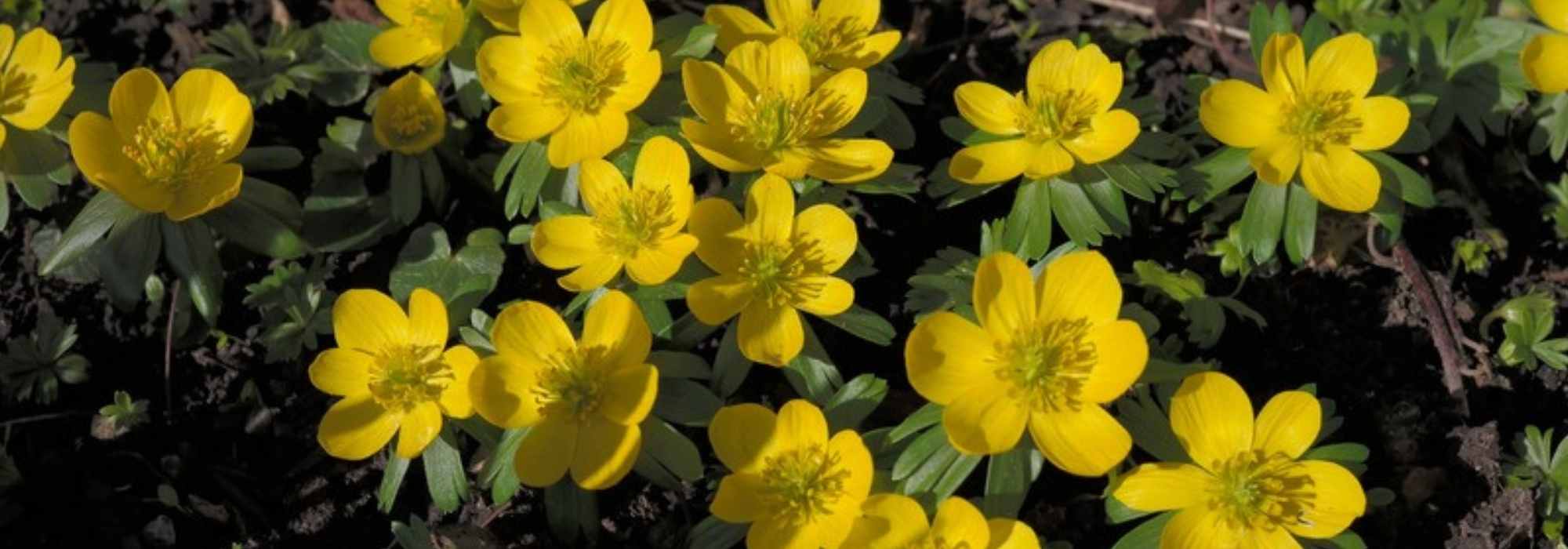
Eranthis or winter aconite: planting, growing
Contents
Eranthis in a nutshell
- Eranthis is one of the first bulbs to flower in the heart of winter
- This lovely tuberous perennial forms a small groundcover adorned with bright yellow flowers, shining like large buttercups
- Low maintenance and hardy, it naturalises very easily and forms vast flowering carpets
- It is a little winter sun best suited to cool soils
- Its cheerful flowering brightens the base of trees, borders, lawns, rockeries, natural beds, and ephemeral pots
A word from our expert
Winter Aconite (Eranthis in Latin), also known as Yellow Hellebore or Winter Hellebore, is a small perennial bulbous plant among the first to flower at the end of winter. The delicately scented flowering occurs in February-March, sometimes as early as the end of January, coinciding with the snowdrops.
In our gardens, Eranthis hyemalis and Eranthis cilicia. are among the most common. Standing at 10 cm tall, the winter aconite spreads in a groundcover carpet dotted with bright yellow flowers, resembling buttercups. It is perfect for colonising slopes or the base of deciduous trees or bushes, rockeries, a pathway border, or even a planter.
In well-drained, calcareous soil, it will easily naturalise, forming flowering carpets over several square metres over time.
Discreet for the rest of the year until it disappears in summer, easy to care for, and perfectly hardy, it grows almost everywhere in France without requiring maintenance.
Discover this little sun that brightens winter days!
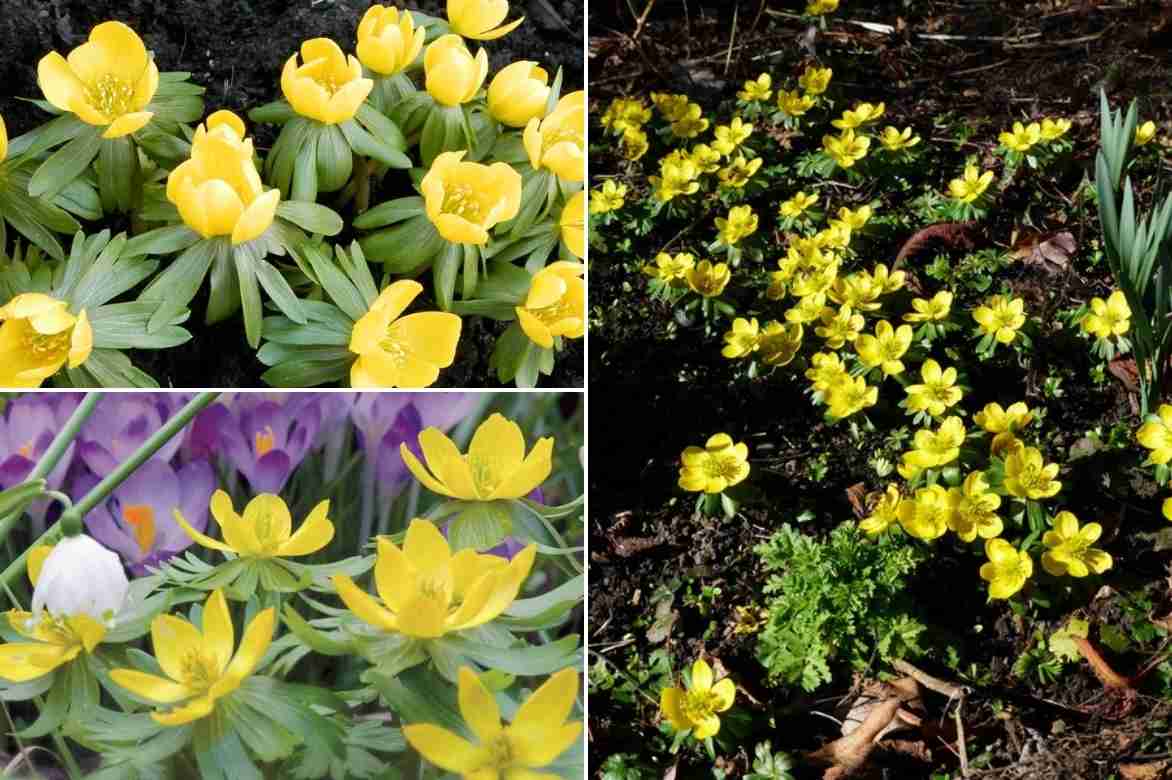
Eranthis hyemalis and Eranthis cilicia (bottom left)
Description and botany
Botanical data
- Latin name Eranthis
- Family Ranunculaceae
- Common name Winter Aconite, Helleborine
- Flowering January to March
- Height 10 cm
- Exposure Sun, Partial shade
- Soil type well-drained, humus-bearing, calcareous
- Hardiness below -15°C
Eranthis, also known as Aconite, Yellow Helleborine, or Winter Aconite, is a small bulbous and tuberous perennial. It belongs to the family of Ranunculaceae, like Aconites, Wood Anemones, and buttercups, our famous buttercup. It is native to Central Europe and the Middle East (Turkey, Syria, Afghanistan), where it grows in scattered pine forests and in clear, moist undergrowth.
Perfectly adapted to our climates, it is notably found in France and Belgium where it has naturalised. Alongside Eranthis hyemalis, the most common species, there are other species of Eranthis, such as E.cilicia with larger flowers and more finely divided foliage, or Eranthis pinnatifida which is distinguished by its white flowering. Eranthis Tubergenii is a large hybrid. These are very prolific species that are easy to naturalise in clear undergrowth or in hard-to-reach slopes of the garden.
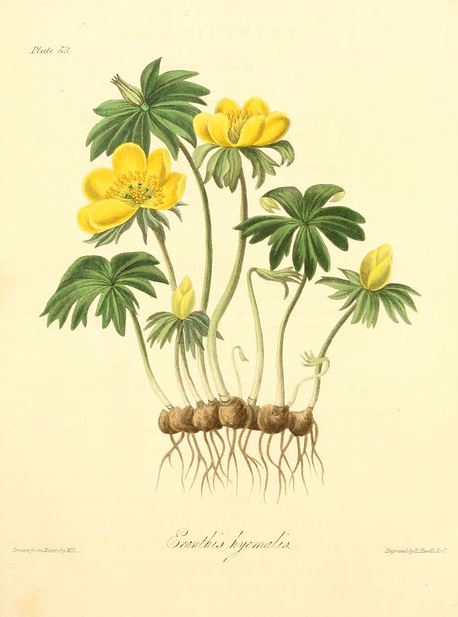
Eranthis hyemalis, botanical plate
This perennial with a tuberous root spreads as a groundcover carpet. The dark, round, flat tubers produce several stems. In winter, when it is almost forgotten, it emerges from the ground to form a very low tuft not exceeding 10-15 cm in height and flowers almost immediately. It is a small plant, but it can form an impressive carpet of flowers over several square metres. Eranthis flowers early in the season, as early as January depending on the climate, often piercing through the snow, before the foliage appears.
Alongside snowdrops, Leucojum, and crocuses, its flowers are among the beautiful surprises of the garden in winter. Flowering occurs from late January to March, depending on climatic conditions, at the same time as snowdrops. In Greek, its name means “the spring flower in winter.”
Each short stem bears a solitary flower shaped like a star cup with 5 to 8 incurved petaloid sepals. There are rare semi-double to double forms. The flowers, measuring 2 to 4 cm in diameter, are truly bright and resemble those of buttercups and hellebores or “Christmas roses,” hence its sometimes-used nickname of winter hellebore and Helleborine. They are set on a collar of finely laciniate green petaloid sepals.
Most of them display a beautiful bright golden yellow colour, sometimes orange-yellow, lemon yellow, or creamy yellow, but more rarely pinkish white in some varieties. This involucre serves as a casing for this early flowering delicately scented. The flowers only open with the sun, closing at night and when the weather is overcast.
After fertilisation, they transform into fruits that are elongated follicles 1 to 2 cm long, releasing small round brown seeds: the plant easily multiplies by spontaneous sowing.
The deciduous foliage appears after flowering. It forms a tuft composed of palmate basal leaves, divided into lobes and finely incised into strips. Once flowering is finished, the foliage continues to thicken, forming small umbrellas measuring up to 10 cm in diameter. Then, in mid-spring, the foliage yellows and the plant enters dormancy, disappearing by late summer. Bright green to light green and glossy, it sometimes takes on bronze or copper hues.
The sap is irritating to the skin, and all parts of the plant are toxic, especially the roots… but only in case of ingestion.
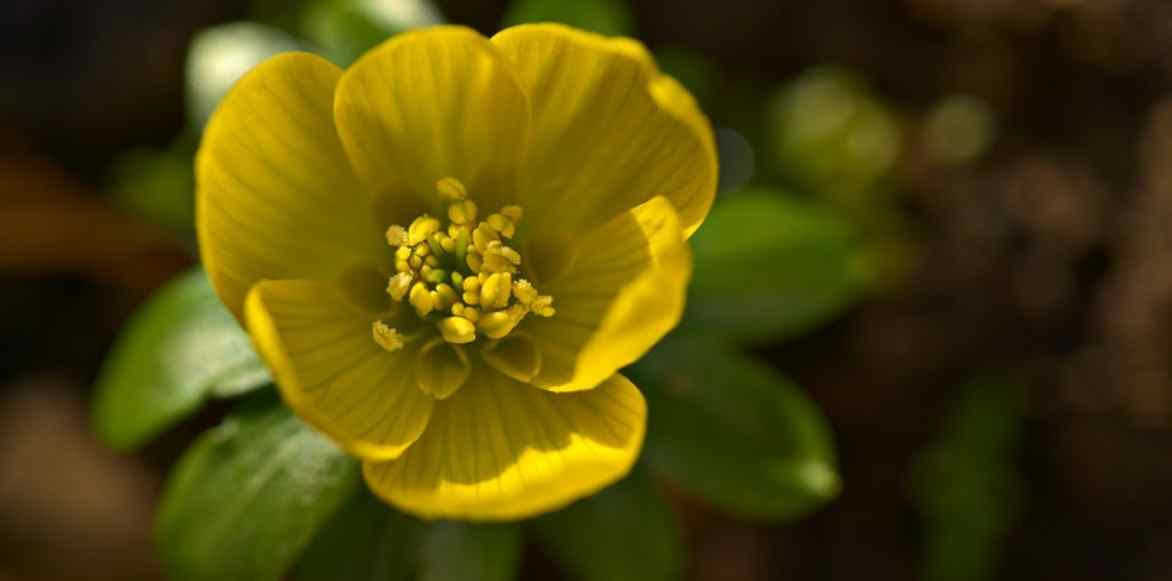
Eranthis hyemalis (Photo: P. Stenzel)
“`
Main species and varieties
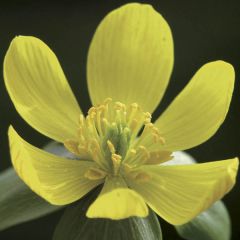
Eranthis hyemalis - Winter Aconite
- Flowering time March, April
- Height at maturity 10 cm
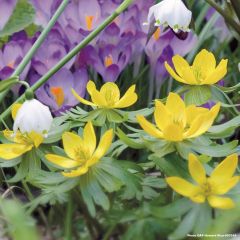
Eranthis cilicica
- Flowering time April
- Height at maturity 10 cm
Planting
Where to plant Eranthis?
Eranthis is a plant perfectly suited to our climates. Very hardy, it withstands snow and can resist temperatures as low as -20 °C to -30 °C, allowing it to adapt to all regions of France. However, as it dislikes soils dried out by intense summer heat, it may struggle in Mediterranean climates.
It multiplies quickly in calcareous, humus-bearing, and cool soil. Avoid waterlogged areas that promote the rotting of tubercles, and ensure good soil drainage.
Winter aconite thrives in full sun or possibly partial shade for complete flower opening.
Once established, it self-seeds easily, forming colonies quickly without maintenance, and does not become truly invasive, as there are few competing plants during its flowering period. This is a planting to leave in place, as the aerial part completely disappears in spring.
Its ability to naturalise makes it an ideal plant to scatter in lawns, creating flowering carpets in winter, or as groundcover on difficult slopes. It also enjoys light woodland at the base of deciduous trees, along pathways or borders, in cool rockeries without smothering existing plants, or in pots alongside other bulbous plants.
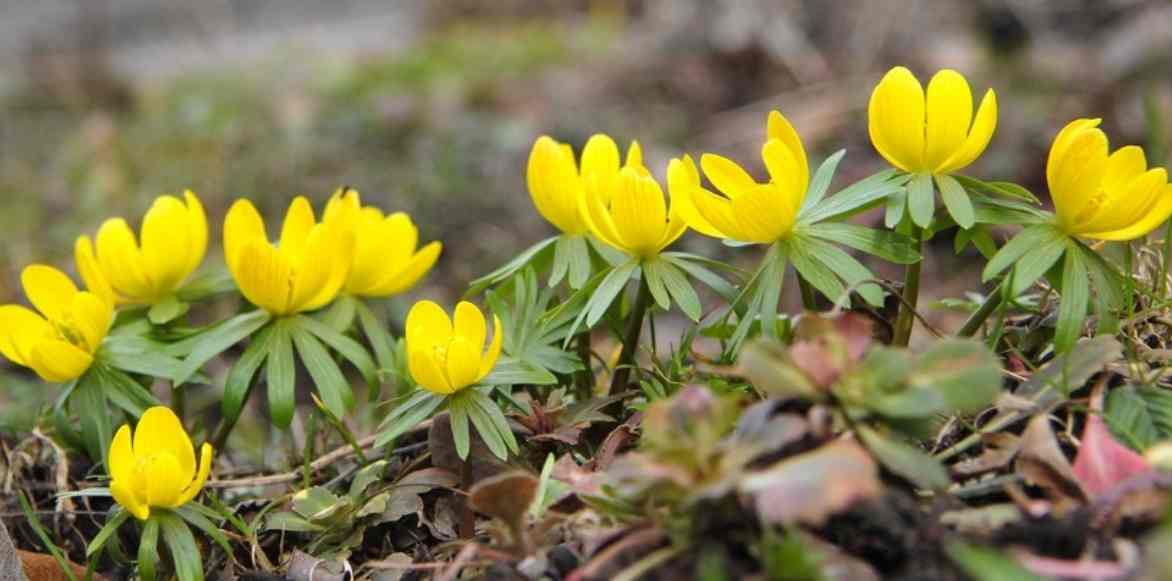
Eranthis thrives in partially shaded areas, illuminating spring with its vibrant flowers
When to plant?
Plant Eranthis in autumn from September to mid-October.
How to plant?
The small tubercles are sensitive to drought and may be dried out at the time of planting. To encourage recovery, soak them in lukewarm water for 24 hours to rehydrate.
In open ground
- Plant the tubercles about 5-7 cm deep in a mixture of soil and compost, spacing them 5 cm to 10 cm apart.
- Cover them with fine soil and firm it down.
- Water well.
In pots
You can also plant Eranthis tubercles in pots or window boxes, alongside other bulbous plants. Count on about ten tubercles for a pot with a diameter of 20 cm.
- Drain the bottom with a layer of gravel or broken pot pieces.
- Fill it with compost mixed with a little sand.
- Place your bulbs, then cover them with substrate.
- Firm down and water.
Read also
6 bulbs easy to naturalise in the gardenCare
Winter aconite requires very little maintenance as, once well established, it thrives without needing special attention. Generally, maintenance simply involves removing faded flowers if you want to control its spread by preventing self-sowing. Keep the soil moist in summer with regular watering, especially during dry spells. Only potted plants require more frequent watering.
Although not necessary, you can spread a few handfuls of organic fertiliser at its base in autumn. As it disappears underground in winter, we recommend marking its location with a label, which will help you find it and protect it from slugs if necessary as soon as its young foliage reappears.
Allow the foliage to yellow and dry completely before cutting it back, as this enables the plant to replenish its reserves for flowering the following year. Once in dormancy, it will require no further maintenance. After 3-4 years, when the foliage thins and flowering diminishes, it is time to divide the clumps to keep them vigorous.
Diseases and potential pests
When grown under good conditions, Eranthis is not afraid of much and returns faithfully year after year. Grey rot caused by excess water is its main enemy. Slugs can threaten its foliage in spring: discover our 7 ways to fight slugs effectively and naturally and how to make a slug trap?
Multiplication
Eranthis easily tends to naturalise and multiplies through spontaneous sowing over the years or by sowing at the end of summer. We recommend multiplying it by dividing the tubercles in autumn or spring after flowering (in March-April), a technique that is much more reliable and quicker than sowing, which will take four to five years before you see them flower. Division is very simple to do, on mature clumps of at least 3 years. It helps to maintain vigorous and floriferous plants.
- Using a fork, lift the clump out of the ground
- Separate the tubercles, by hand or with a small knife
- Cut off the dried leaves
- Replant immediately at a depth of 5-8 cm in open ground or in pots for planting in open ground the following spring
- Cover them with a mixture of soil and compost
- Firm down and water
Pairing ideas
With their bright and early flowering, Eranthis allow for the creation of a colourful display very early in the season, awakening the garden still slumbering from winter. Faithful, they easily spread in naturalistic or wild gardens. These small tubercles are perfect for colonising difficult-to-access slopes, flowering borders around the house, a lawn, the base of trees, ephemeral pots, or enlivening a rockery.
They are among the first flowers to appear in spring, alongside crocuses, snowdrops, snowflakes, and Scillas, with which they form early and cheerful flowering carpets, heralding the arrival of spring. They can be planted, for example, under a Hamamelis (x) intermedia ‘Arnold Promise’ or near a Mahonia ‘Soft Caress’, with its bright yellow winter flowering: they will enliven their base in the depths of winter.
Combine them with other early naturalising bulbs that reliably flower each year, such as daffodils, chionodoxas, Blanda anemones, hyacinths, or even ipheions, which will help stagger the flowering periods. Planted in numbers, these small tubercles form carpets of yellow flowers. You will achieve effective contrasts yellow/blue by pairing them with the blue flowers of Muscari.
In borders, they slip in everywhere among plants and pair well with Oriental hellebores, winter heathers, primroses, and Vinca minor. In a cool rockery, they will thrive alongside Cyclamen coum.
They are well-suited for pot cultivation on a windowsill, terrace, or balcony, mixed with crocuses, pansies, small daffodils, botanical tulips, or forget-me-nots, extending the flowering season.
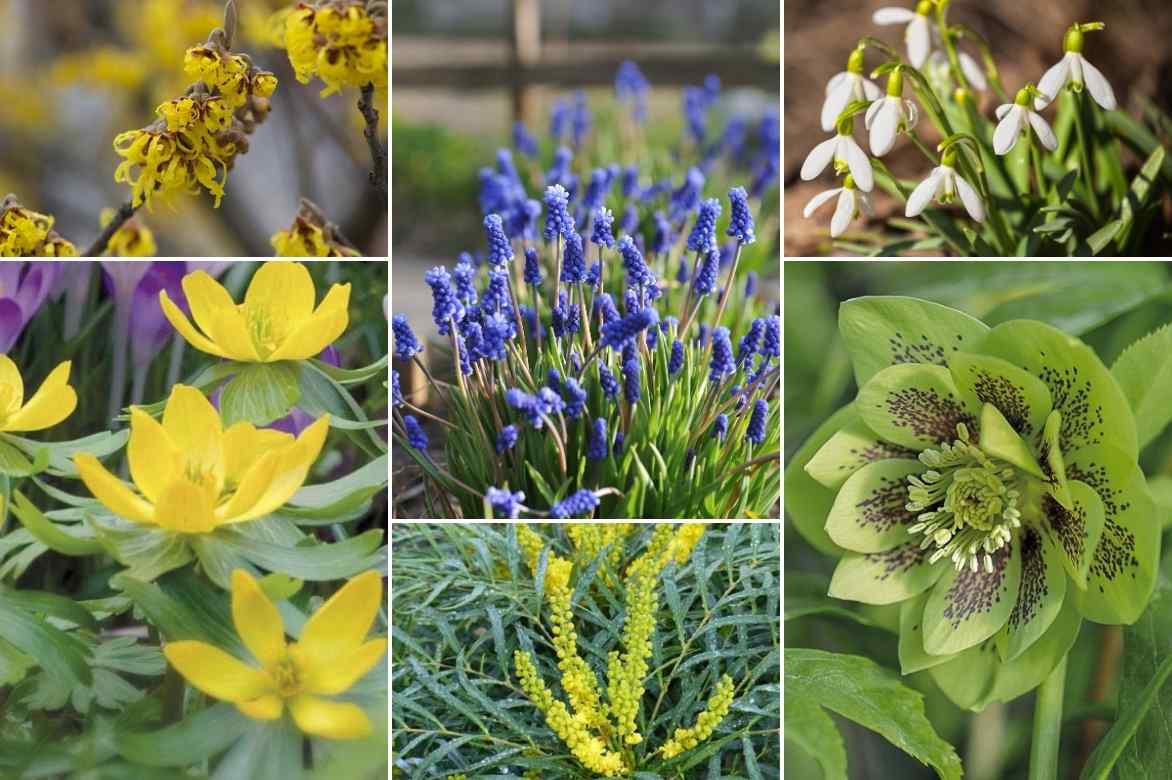
Erianthis cilicica alongside Hamamelis ‘Arnold Promise’, Muscari, Mahonia ‘Soft Caress’, snowdrops, and Hellebore ‘Double Green Spotted’
Useful resources
- Small bulbs, big impact! An article to discover on our blog!
- Discover our naturalising bulbs!
- Article: 5 early winter flowering bulbs
- Marion’s tips in Brighten up shady areas with spring bulbs!
- Subscribe!
- Contents































Comments